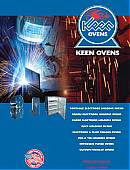Industrial Ovens
Front-Loading
![]() Under 10 cubic feet
Under 10 cubic feet
![]() 10-20 cubic feet
10-20 cubic feet
![]() Over 20 cubic feet
Over 20 cubic feet
![]() See All
See All
Top-Loading
![]() Under 10 cubic feet
Under 10 cubic feet
![]() 10-20 cubic feet
10-20 cubic feet
![]() Over 20 cubic feet
Over 20 cubic feet
![]() See All
See All
Learn About Our Industrial Ovens
Welding Ovens
![]() Stick Electrodes
Stick Electrodes
![]() Sub-Arc Flux
Sub-Arc Flux
![]() Wire Spools
Wire Spools
![]() Tig Filler Wire
Tig Filler Wire
![]() Multi-Purpose
Multi-Purpose
![]() Nitrogen Purge
Nitrogen Purge
![]() See All
See All
 Order Our Free Catalog Today Click Here |
| Available Inventory |
Welding Granular FluxGranular flux used in welding is a type of flux that is made up of numerous small particles. In Submerged Arc Welding (SAW), the granular flux provides a blanket over the weld, which protects against sparks and splatter. In SAW, the granular flux is frequently the means for achieving high deposition rates. The flux is also instrumental in producing the type of quality weld that is common in this particular welding process. Click here to view our welding ovens and to learn Functions of Flux in Sub Arc WeldingThe effect of gravity on the flux feeding into the weld area and the molten weld pool limits the versatility of Submerged Arc Welding. This process must be performed in the flat and horizontal fillet positions only, except in special cases. These special cases include vertical and horizontal welds using special equipment, such as belts or shoes, to hold the flux in position. The granular flux used in SAW serves several functions. In addition to providing a protective cover over the weld, the flux shields and cleans the molten puddle. The flux also affects the chemical composition of the weld metal, the weld bead shape, and the mechanical properties of the weld. Another function of granular flux is to act as a barrier that holds the heat in and concentrates the heat into the weld area to promote deep penetration. Types of Granular FluxesThe methods used to manufacture fluxes determine the flux types. There are fused fluxes, bonded fluxes, agglomerated fluxes, and mechanically mixed fluxes. When manufacturing fused fluxes, raw materials are melted into a liquid state with a high temperature electric furnace. The material is then cooled and crushed or ground into the desired particle size. When making bonded fluxes, the ingredients are dry mixed, then glued together with a liquid binder. This binder may be a liquid such as sodium silicate. After the particles are bonded, they are baked and then sifted through a sieve to attain flux particles of the desired size. Agglomerated fluxes are manufactured much the same way that bonded fluxes are made. However, instead of a liquid binder, a ceramic binder is used. A higher drying temperature is used, too. (The higher drying temperature limits the use of deoxidizers and alloy elements.) Fluxes that are mechanically mixed are combinations of two or more bonded or agglomerated fluxes. Although mechanically mixed fluxes make it possible to create special mixtures for more sensitive welds, these fluxes may separate during storage, use, and recovery of flux.
|